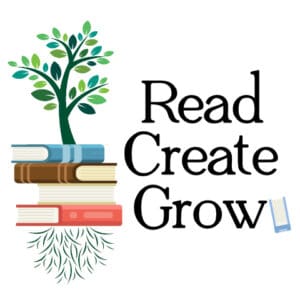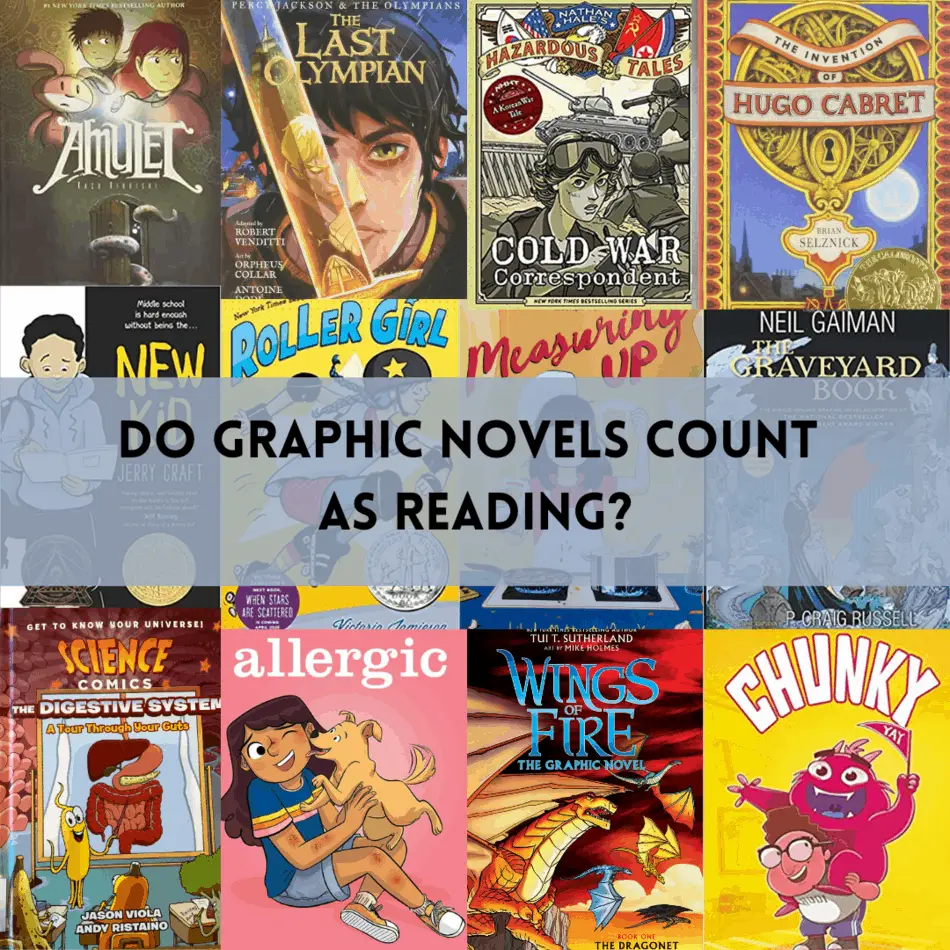In the library kids happily sit on the floor of the DEWEY 741.5 aisle pulling all their favorite graphic novels from the shelves, while their parents surreptitiously ask me whether graphic novels even count as “real” reading.
Reading graphic novels does count as reading because it uses the same skills as reading novels. While graphic novels provide fewer words per page than a chapter book, they still follow the structure of a traditional novel, require children to decode words, analyze meaning, and build vocabulary through illustrated context clues.
Continue reading to learn more about what graphic novels are and what there impact is on your child’s reading skills and how to help them transition to traditional novels.
*This post may contain Amazon or other affiliate links. As an Amazon Associate I earn from qualifying purchases.
What is a graphic novel?
A graphic novel is a complete, full length story with a story arc featuring a beginning, middle and end. The story has illustrations which enhance the storytelling and allow for less text. This differs from a comic because comics are serialized and only contain a small part of a larger story.
Additionally, “graphic novel” is a format, not a genre. They exist in fantasy, fiction, memoirs and biographies, even non-fiction books for science and history are being made to entice kids into other areas of reading.
How do graphic novels help with reading?
Surprisingly, graphic novels build reading skills in several ways. Adults are frequently concerned that fewer words in the text means less reading is taking place, however graphic novels are highly beneficial for readers of all levels.
Children who struggle or are reluctant to read can find graphic novels an approachable way to tackle age-appropriate reading material. There are fewer words which make the reading less intimidating, but the content is still interesting and relevant for their age.
While there might be fewer words than a traditional novel, there still exists plenty of text for kids to decode and analyze, all while following the arc of a story.
Graphic novels still feature more unique words than spoken conversation, even if there are fewer than traditional novels. A study done by the University of Oregon Center on Teaching and Learning found that comics averaged 53.5 rare words per 1000, which was more than adult books, picture books or the conversations of college graduates (source).
Evidence also suggests that graphic novels introduce more complex words at a younger age than traditional age-appropriate novels because the illustrations support word meanings (you can read the scientific data here and here). The aide of graphics allows kids to develop their reading comprehension through context clues provided in the visual illustrations and even build empathy. This allows kids to build up their vocabulary and reading comprehension skills in a similar way to traditional reading.
Struggling or reluctant readers can use graphic novels to keep up with many of the same stories their friends are reading but in a more approachable format. Many popular books have been turned into a graphic novel series, such as Percy Jackson and the Olympians and the Wings of Fire series, allowing kids who may struggle with that much text to still read the same stories as their friends.
Read More: How to Hook a Reluctant Reader
Are graphic novels appropriate for children?
In 1954 Fredric Wertham made a long since refuted claim that linked reading comics with juvenile delinquency. There was of course, absolutely no validity to this statement, but the stigma against comics and graphic novels has subconsciously persisted to this day.
A graphic novel, like any other traditional full-length book, has varying degrees of appropriateness that a caregiver or teacher will need to determine for themselves. We talk more in depth about how to determine if a book is appropriate and how to choose the right books for kids in this article.
The power of graphic novels is that they allow children to wrestle with challenging topics in a more approachable way. Heavy topics such as the loss of a parent, adoption, bullying, puberty, making friends, racism or issues at school can be made more intimidating by looking at three hundred pages of text. Colorful animated illustrations can make a heavy topic more approachable and even more age appropriate.
Are graphic novels bad for kids?
While graphic novels offer many opportunities for access for kids who struggle to read in terms of vocabulary development and age appropriate stories, and they are not “bad” per say, there are some downsides to exclusively reading graphic novels that parents and teachers need to be aware of.
At some point, kids have to read longer texts, and debate still rages between scientists about whether or not graphic novels train the brain to read long stretches of text at one time in the same way as traditional novels. Much of the data suggests that kids still learn enough unique words when reading graphic novels and spend time decoding, but there just isn’t enough data to know if this will transfer to reading traditionally printed text books in college, technical manuals or other text-rich documents.
An additional argument against reading graphic novels exclusively, which can also be applied to reading any other subject exclusively, is that a hyper-narrow focus is limiting. Only reading one subject, or one format of book, may expand vocabulary related to that subject, but only that subject. It is beneficial for kids to get some broader reading experience, even if the issue is exclusively reading one genre.
If you are concerned your child is only reading graphic novels and refuses to read anything else, there are some ways to help them transition to traditional novels. Of course, if your child has a learning difficulty or physical challenge that makes this difficult then you may need to seek out special counseling in this area.
How to transition from graphic novels to chapter books
1. Add in magazines to their regular reading material
It may seem like magazines are little better than graphic novels, however they provide more paragraphs of text in one stretch than a graphic novel, but are still broken up with colorful images. This keeps the approachability of a graphic novel, minimizes the pages of text but still provides more words to read in one sitting. You can try subscriptions or check out magazines at your local library for subject variety too.
2. Explain your reasoning for encouraging them to read more traditional novels
Don’t make a beloved graphic novel sound evil, just gently explain that while there are many things to love about graphic novels, it is good to expand reading interests as well. There are a lot of wonderful stories out there that can’t be graphic novels. It also might take some time to find the ones he really loves, which is also okay. Every book doesn’t have to be a winner, the importance is to try some different things.
3. Read a chapter book together
Reading together provides time to bond with your child and allows them to hear what some of the more challenging words sound like before having to decode them themselves. Take turns reading a page or chapter aloud, whatever your child is comfortable with. You can always start with reading a page each and then build up to longer reading periods.
4. Read a variety of graphic novel genres
Graphic novels are a format, not a genre. So be sure to read from several different genres to find out what else your child likes. Include some nonfiction as well. Science Comics covers a variety of different STEM subjects, and Nathan Hale’s Hazardous Tales covers much of American history as well as World War I and II.
5. Try including transitional graphic novels or illustrated novels
Illustrated novels like Diary of a Wimpy Kid or Dork Diaries can offer the best of both worlds. There will be a page or two of text paired with large illustrations. The fonts can also vary in size and shape making the reading more interesting and feel less formal. Transitional graphic novels like Brian Selznick’s books, The Invention of Hugo Cabaret, also offer a mix between reading a full page of text and a full page of graphics (plus the illustrations are amazing).
6. Pair the book with a fun non-reading activity
Make reading fun by bringing real-world experiences into it. Plan a movie night after reading the book and talk about the differences and which your child liked better and why. Read a Science Comic or and pair it with a science experiment. Read a Hazardous Tale and visit a history museum. This is less about bribing kids to read and more about helping them draw connections to the world and sparking interest in different subjects.
7. Rotate graphic novels with traditional novels
Graphic novels are still a wonderful reading tool and can be a fun experience. Just because your child needs to or is starting to enjoy traditional chapter books doesn’t mean graphic novels are now dead. It is important for your child to know that reading other books doesn’t mean they can never read a graphic novel again. This is not an “all or nothing” situation. Knowing that can help take the pressure off the situation as well. Your child will know that they can always pick up a graphic novel if they want to and that starting to read traditional books does not mean they are losing a beloved format.
8. Focus on books that are part of a series
Try to choose books that are part of a series to keep your child interested in the story. There will be more to read and it helps them get invested in the characters and plot.
9. Look for books that have both a graphic novel and a traditional novel
A lot of books are being turned into graphic novels. If your child has read and loved a Nate Pierce graphic novel, it might be an easier transition to the full-length novel format (which in this instance features a lot of illustrations). Try this with Wings of Fire, Percy Jackson and the Olympians, The Graveyard Book as well as different versions of certain fairy tales, and more. Read them both and compare them. Or have your child read the graphic novel first, then the full length and see if that aides in their interest and understanding of the story. They might be less intimidated if they already have a jumping off point for context and imagination.
Try any of these tips and see if it helps encourage your child to explore formats outside of graphic novels and new genres. In the end, though, just remember that if your child enjoys reading something then that is always better than nothing. If all they want to read is graphic novels and nothing else will do, it’s not the end of the world, because reading graphic novels does count as reading.
*This is, of course, a general guide and is not meant to diagnose. If you have concerns about your child’s behavior or development please be sure to speak with a medical professional, your child’s physician or teacher.












